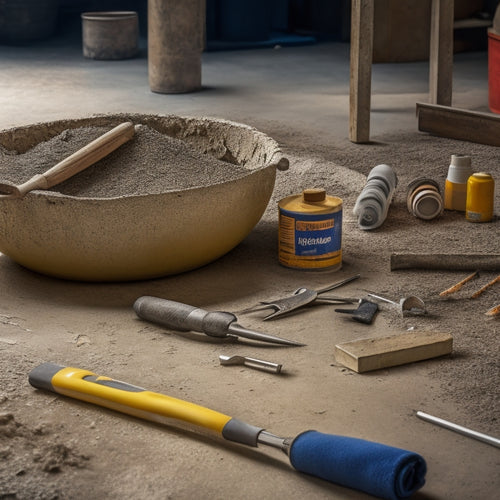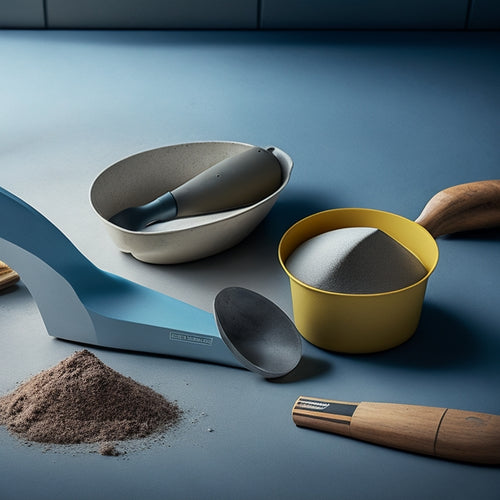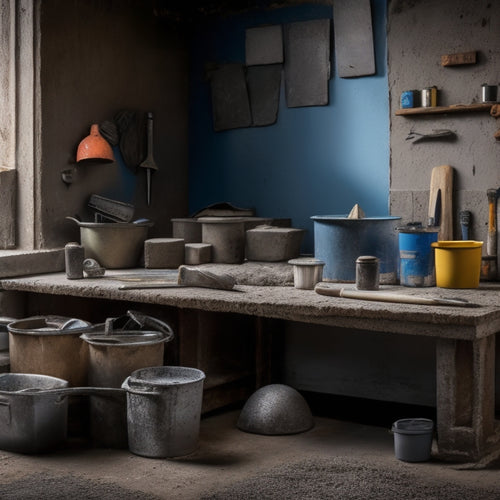
7 Must-Have Tools for Smooth Concrete Walls
Share
To achieve a flawless, smooth finish on your concrete walls, you'll need to stock up on the right tools. Your arsenal should include a high-quality trowel for initial smoothing, an edger for crisp lines, and a float for surface blending. A finishing trowel is also essential for achieving perfection, while a power trowel will greatly reduce time and effort for large projects. Don't forget an edging tool for precise corner control, and a grout float for final touches. With these seven must-have tools, you'll be well on your way to creating a smooth, professional-looking concrete wall. Now, get familiar with the finer details to take your skills to the next level.
Key Takeaways
• A high-quality trowel is essential for achieving smooth concrete walls, with V-notched and flat trowels serving different purposes.
• A finishing trowel is necessary for perfection, with adjustable angles and regular maintenance enhancing performance and reducing imperfections.
• A float is used to blend the surface, feathering out imperfections for a uniform finish, with magnesium and aluminum/resin options available.
• Edging tools, including edgers and corner tools, create clean lines, define edges, and enable precise corner control and angle cuts.
• Advanced finishing tools, such as power trowels and smooth radius finishing tools, increase efficiency and enable seamless, rounded joints in curved surfaces.
Trowel for Initial Smoothing
As you begin the process of achieving a smooth concrete wall, a high-quality trowel is vital for initial smoothing, allowing you to remove excess material and create a uniform surface.
You'll find that there are several trowel types to choose from, each designed for specific tasks. For instance, a V-notched trowel is ideal for applying and spreading concrete, while a flat trowel is better suited for smoothing and finishing.
When selecting a trowel, consider the type of concrete you're working with and the desired finish. It's also essential to maintain your trowel properly to guarantee peak performance. Regularly clean your trowel with a wire brush to remove dried concrete and debris.
Store it in a dry place to prevent rust, and apply a rust inhibitor if necessary.
Proper trowel maintenance is key to achieving a smooth, even finish. A well-maintained trowel will help you achieve consistent results and reduce the risk of imperfections.
Edger for Clean Lines
Your edger is the tool responsible for creating crisp, clean lines and defining the edges of your concrete wall, allowing you to achieve a professional-looking finish. This tool is vital for creating a smooth, seamless joint where the wall meets the floor, ceiling, or other surfaces.
When choosing an edger, you'll come across different types, including manual, electric, and pneumatic models. Each has its own advantages, so evaluate your specific needs and preferences before making a decision.
The blade material is another important factor to take into account. Carbide-tipped blades are popular for their durability and ability to withstand the abrasive nature of concrete. Diamond-coated blades, on the other hand, provide a more aggressive cutting action and are ideal for thicker concrete or those with high aggregate content.
You may also opt for blades with specialized coatings, such as silicone or ceramic, for improved performance and reduced wear. Regardless of the type and material, make sure to maintain your edger regularly to guarantee clean lines and a smooth finish.
Float for Surface Blending
With a clean edge established, you'll next use a float to blend the surface of your concrete wall, feathering out any imperfections or inconsistencies to achieve a uniform, even finish. This critical step requires attention to detail and the right techniques to guarantee a smooth, blemish-free surface.
When selecting a float, consider the material: magnesium floats are ideal for most applications, while aluminum or resin floats are better suited for specialized tasks. The float's size and shape also matter, as they affect the surface area covered and the ease of maneuverability.
Mastering float techniques is essential for a flawless finish. Start by holding the float at a 45-degree angle, then gradually increase the pressure as you work your way across the surface. Use long, smooth strokes to blend the concrete, overlapping each pass to prevent visible lines.
Finishing Trowel for Perfection
As you move on to the finishing stage, you'll need to adjust the angle of your trowel to achieve a flawless finish.
You'll find that a subtle change in angle can make all the difference in achieving a smooth, even surface.
Trowel Angle Matters
You adjust the angle of your finishing trowel to achieve a perfect, even finish on your concrete wall. This subtle adjustment can make all the difference in the quality of your work. A slight variation in angle can affect the way the concrete spreads, resulting in an uneven or blemished surface. To master the art of troweling, it's important to understand the best angles for different stages of the finishing process.
| Trowel Angle | Effect on Finish |
|---|---|
| 15-20° | Ideal for initial spreading and leveling |
| 20-25° | Suitable for secondary spreading and smoothing |
| 25-30° | Best for final finishing and achieving a high-gloss finish |
Maintaining a consistent trowel angle is key to achieving a smooth, even finish. Regular trowel maintenance, including cleaning and sharpening, is also necessary to make sure the tool performs at its best. By honing your trowel technique and adhering to these guidelines, you'll be well on your way to producing exceptional results that showcase your skill and attention to detail.
Smooth Finish Guaranteed
Smooth Finish Guaranteed
To achieve a flawless, high-gloss finish, a finishing trowel is an essential tool that requires precise technique and controlled strokes to eliminate even the slightest imperfections.
You'll need to master the art of holding the trowel at a 45-degree angle, applying consistent pressure, and making smooth, overlapping passes to achieve a uniform finish. Remember, the key to success lies in your surface preparation techniques. Ascertain the concrete is properly cured, and the surface is free of defects and excess moisture.
When using a finishing trowel, you'll want to work in small sections, about 4 feet by 4 feet, to maintain control and precision.
As you apply the finishing strokes, pay close attention to the concrete curing methods, as this will affect the final appearance of the surface. By combining the right technique with the right tools, you'll be able to achieve a smooth, glossy finish that's free of imperfections.
With practice and patience, you'll be able to produce walls that exude perfection and professionalism.
Power Trowel for Efficiency
By incorporating a power trowel into your finishing process, you'll greatly reduce the time and effort required to achieve a high-quality, smooth finish on your concrete walls. This powerful tool is designed to optimize your workflow, allowing you to cover large areas quickly and efficiently. With a power trowel, you can achieve a superior finish that meets the highest standards.
Here are three key benefits of using a power trowel:
-
Increased productivity: Power trowels can cover up to 10 times more area than traditional hand trowels, making them ideal for large projects.
-
Improved consistency: With a power trowel, you can maintain a consistent finish across the entire surface, eliminating imperfections and unevenness.
-
Enhanced control: Power trowels offer precise control over the finishing process, allowing you to adjust speed and pressure to suit your specific needs.
Edging Tool for Corners
When you're working on smooth concrete walls, you'll need an edging tool that can handle corners with precision.
You'll want to maintain corner edge control, make precise angle cuts, and achieve smooth radius finishing to guarantee a professional-looking result.
Corner Edge Control
You'll need a corner edge control, a specialized edging tool designed to create crisp, 90-degree corners and maintain a consistent joint width. This tool is essential for achieving professional-looking results in your concrete wall project.
With a corner edge control, you'll be able to master corner shaping techniques and guarantee precise edge sealing methods.
Here are three key benefits of using a corner edge control:
-
Accurate Corners: This tool helps you create sharp, 90-degree corners with ease, eliminating the risk of uneven or rounded edges.
-
Consistent Joint Width: Corner edge control guarantees a consistent joint width throughout your project, giving your concrete wall a uniform and polished appearance.
-
Time-Saving: By using a specialized tool for corner edging, you'll save time and effort, allowing you to focus on other aspects of your project.
Precise Angle Cuts
Two precise angle cuts, typically 22.5 and 45 degrees, are vital for creating complex corner designs and decorative edges in your concrete wall project. To achieve these cuts, you'll need an edging tool specifically designed for corner work.
This tool allows you to make precise angle cuts, guaranteeing a seamless joint where the walls meet. When choosing an edging tool, look for one with adjustable angle settings and a sturdy build to withstand the demands of concrete cutting.
To execute these cuts, you'll need to master cutting techniques that involve measuring and marking the angles accurately. Angle measuring is essential, as even a slight miscalculation can throw off the entire design.
Use a high-quality angle measuring tool to guarantee accuracy. Once you've marked the angles, use your edging tool to make the cuts. Remember to work slowly and deliberately, as the precision of your cuts will directly impact the final result.
With the right tool and techniques, you'll be able to achieve professional-looking corners that elevate your concrete wall project.
Smooth Radius Finishing
For achieving smooth, curved edges in your concrete wall project, an edging tool specifically designed for smooth radius finishing is essential. It allows you to create a seamless, rounded joint where the walls meet. This tool is a game-changer for curved surface applications, enabling you to master radius shaping techniques with ease.
When choosing an edging tool for smooth radius finishing, consider the following key features:
-
Adjustable radius: Look for a tool that allows you to adjust the radius of the curve to fit your specific project needs.
-
Durable construction: A high-quality edging tool should be built to withstand the demands of concrete finishing, with durable materials and a robust design.
-
Ergonomic handle: A comfortable, ergonomic handle will reduce fatigue and improve control, ensuring a smooth, consistent finish.
Grout Float for Final Touches
As you near the final stages of your smooth concrete wall project, a grout float becomes an indispensable tool for achieving a flawless, even finish.
You'll use it to spread and smooth out grout between the concrete joints, guaranteeing a professional-looking result. When selecting a grout float, consider the materials: rubber, foam, or resin. Each has its advantages, such as flexibility, durability, or ease of cleaning. Choose one that suits your grout application techniques and the specific demands of your project.
To get the most out of your grout float, hold it at a 45-degree angle and press it firmly onto the grout-filled joints. Use a gentle, sweeping motion to spread the grout evenly, feathering it out towards the edges. This technique helps prevent excess grout from accumulating and guarantees a smooth, consistent finish.
Remember to clean your grout float regularly to maintain its effectiveness and extend its lifespan. With the right grout float and techniques, you'll achieve a polished, professional-looking finish that showcases your attention to detail.
Frequently Asked Questions
Can I Use a Single Tool for Both Smoothing and Finishing Concrete?
You're wondering if you can rely on a single tool for both smoothing and finishing concrete.
While it's tempting to simplify your process, the truth is, different smoothing techniques require specific tools to achieve the best results.
Finishing methods, too, demand precision and control.
Using a single tool for both tasks can compromise quality.
Instead, invest in specialized tools to guarantee a flawless, professional finish that meets your high standards.
Do I Need to Use a Specialized Tool for Curved or Irregular Surfaces?
When working with curved surfaces or irregular shapes, you'll need specialized tools to achieve a smooth finish.
A standard trowel or float won't cut it, as they're designed for flat surfaces.
You'll require a tool that can adapt to the unique contours of your concrete.
Look for specialized edgers, curved trowels, or profiled floats that can navigate these complex surfaces with precision, giving you the control you need for a flawless finish.
How Often Should I Clean and Maintain My Concrete Finishing Tools?
You should establish a regular maintenance schedule to guarantee tool longevity.
Clean your concrete finishing tools after each use, and perform a thorough inspection every week.
Remove any concrete residue, and apply a rust-inhibiting coating to metal components.
This routine will prevent damage, reduce wear, and maintain superior performance.
Are There Any Safety Precautions I Should Take When Working With Power Tools?
As you commence on a quest for a flawless finish, remember, safety is the unsung hero that saves the day.
When wielding power tools, you're not just a craftsman, you're a warrior facing potential hazards.
Don your protective gear, the armor of the trade: gloves, safety glasses, and a dust mask.
Guarantee power tool safety by following the manufacturer's guidelines and keeping your workspace tidy.
With caution and control, you'll conquer the concrete jungle, unscathed and triumphant.
Can I Achieve a Smooth Finish With DIY or Homemade Concrete Tools?
You're wondering if DIY concrete techniques and homemade smoothing tools can help you achieve a smooth finish.
While it's possible, you'll face limitations. Homemade tools mightn't provide the same level of precision as professional-grade equipment, leading to inconsistent results.
However, with careful planning and execution, you can still achieve a decent finish.
It's crucial to research and master various DIY techniques to compensate for the lack of specialized tools.
Conclusion
With these 7 must-have tools in your arsenal, you'll be the master of smooth concrete walls.
You'll be able to tackle any project with confidence, like a conductor leading an orchestra.
From initial smoothing to final touches, each tool plays an essential role in creating a flawless finish.
By wielding these tools like a pro, you'll be able to produce concrete walls that shine like a work of art, leaving a lasting impression on all who lay eyes on them.
Related Posts
-

Top Tools for Repairing Cracked Concrete Surfaces
When tackling a cracked concrete surface repair, you'll need the right tools to guarantee a durable fix. Start with e...
-

Ergonomic Concrete Tools for Tight Spaces
When you're tackling concrete work in tight spaces, ergonomic tools are your best bet for comfort and efficiency. The...
-

Top Tools for Beginners in Concrete Masonry Coating
You're about to begin a concrete masonry coating project, and having the right tools is essential. Start with essenti...


